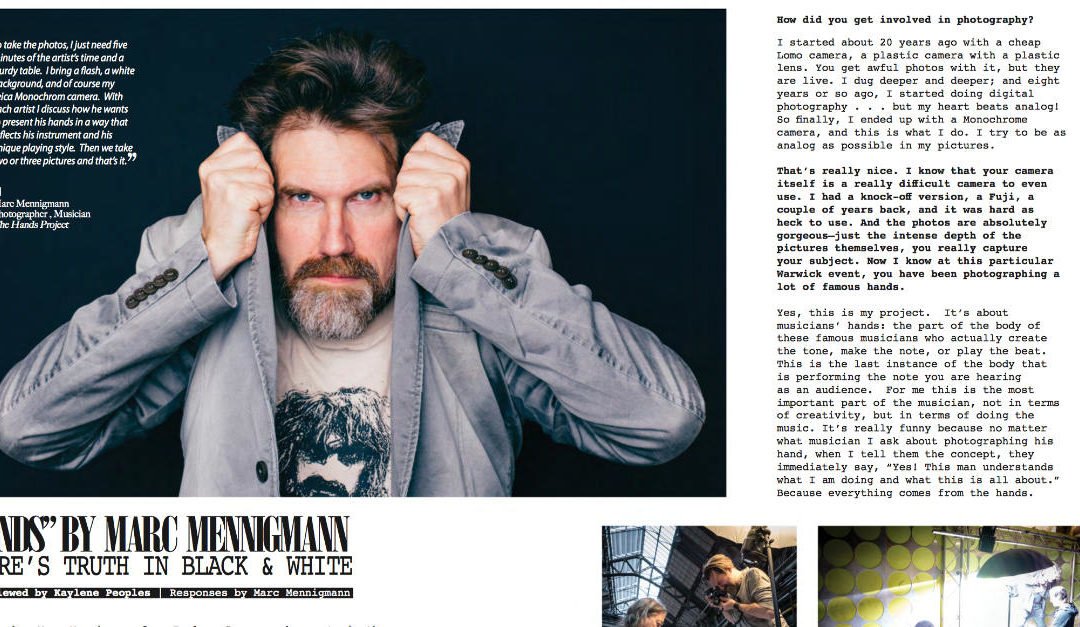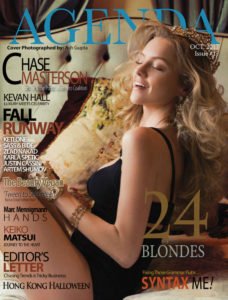By the way, get more info about the just released November ‘ 17 issue of “Agenda” here!
“HANDS” BY MARC MENNIGMANN
THERE’S TRUTH IN BLACK & WHITE
Interviewed by Kaylene Peoples | Responses by Marc Mennigmann
Photographer Marc Mennigmann from Iserlohn, Germany, documents in the rare medium of black and white film. He uses a Leica Mononchrom, which is not only a complex camera, but is known for its rich optics that cater to alternative mediums in photography. Mennigmann chooses to spend his time capturing his subjects in their rawest form, bringing out their essence and exposing a vintage grittiness only seen in rare instances today with the explosion of digital color photography. A purist in the deepest sense, he has started a project called HANDS. Marc has spent hours photographing the hands of famous musicians around the world, and the simplicity of a black and white photograph does his subjects the most justice.How did you get involved in photography?
I started about 20 years ago with a cheap Lomo camera, a plastic camera with a plastic lens. You get awful photos with it, but they are live. I dug deeper and deeper; and eight years or so ago, I started doing digital photography . . . but my heart beats analog! So finally, I ended up with a Monochrome camera, and this is what I do. I try to be as analog as possible in my pictures.
That’s really nice. I know that your camera itself is a really difficult camera to even use. I had a knock-off version, a Fuji, a couple of years back, and it was hard as heck to use. And the photos are absolutely gorgeous—just the intense depth of the pictures themselves, you really capture your subject. Now I know at this particular Warwick event, you have been photographing a lot of famous hands.
Yes, this is my project. It’s about musicians’ hands: the part of the body of these famous musicians who actually create the tone, make the note, or play the beat. This is the last instance of the body that is performing the note you are hearing as an audience. For me this is the most important part of the musician, not in terms of creativity, but in terms of doing the music. It’s really funny because no matter what musician I ask about photographing his hand, when I tell them the concept, they immediately say, “Yes! This man understands what I am doing and what this is all about.” Because everything comes from the hands.
Wow, that’s very deep. What are some of the other things you do as a photographer? How did you develop your style? What were some of your influences?
The influences . . . this is a hard thing because I don’t care about what others do. I only see what pictures I like. And there’s a lot of concept photography, for example, that I do by myself. I see pictures that I like, and from there I try to pinpoint what it is I like from that particular photo I am observing. And this influences my work. So it’s not an artist that influences my work, but the result is art that is influencing my work. This is the same in music. So if you’re listening to music, I think you shouldn’t try to imitate the artist because you’ll never be the artist—it would be boring because we don’t need two of the same artists. You should try to find out what is fascinating you about the music of that artist, and try to involve this into your music, creating your own style. It’s the same thing. So photography and music are pretty much similar.
Do you only shoot in black and white?
Exclusively! This is why I have a camera that produces black and white photos.
What is that like in a world where photography features mainly digital color? You’re definitely setting yourself apart.
Yes, and most of the media doesn’t print my pictures because they are so proud of having color pictures; and the ability to print supersedes printing black and white.
And they’re really missing it. You get the grit of things—you really capture the character of your subject in a black and white photo.
Yes, I agree. Color is distracting. It does not say anything about the soul of the person. For example, when I look at you and see your lipstick—with a black and white picture, it accentuates your lips—the eyes (not the color of your eyes) bring out the soul and subtle nuances of the person. And you don’t need color for that!
Visit Marc Mennigmann at hands-project.de to learn more about The HANDS Project. He has photographed 208 musicians’ hands so far, everyone from Adrian Belew to Al Di Meola and the list is growing!


